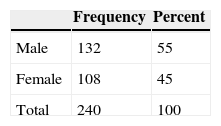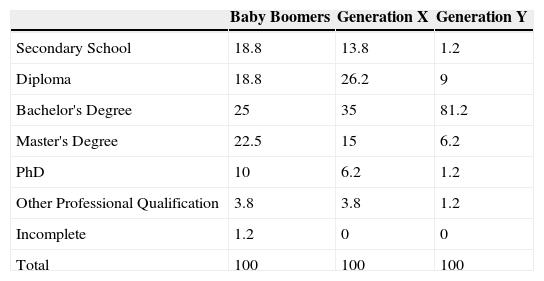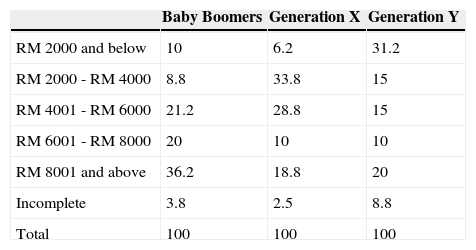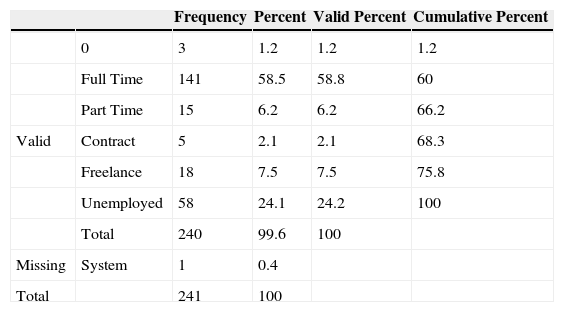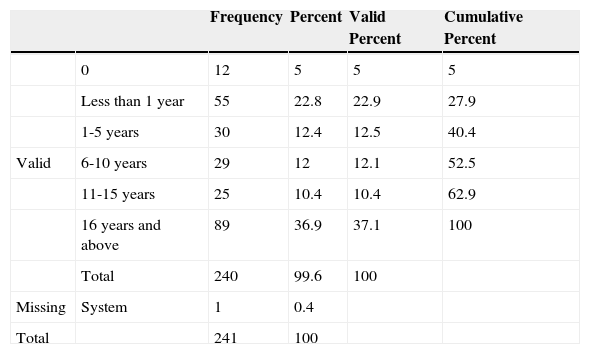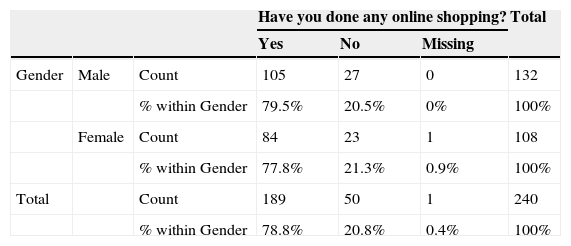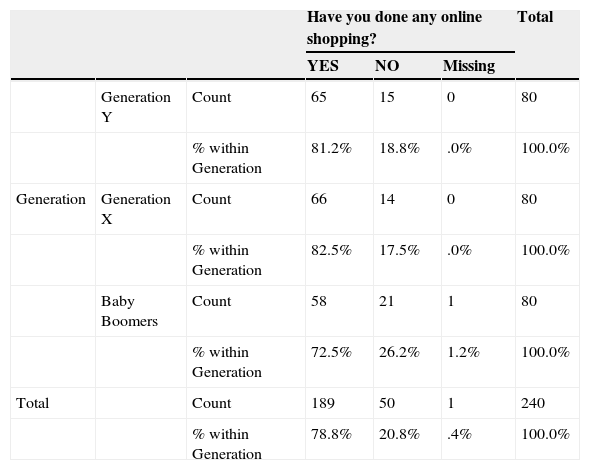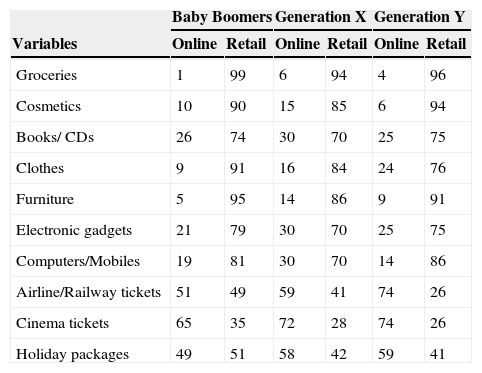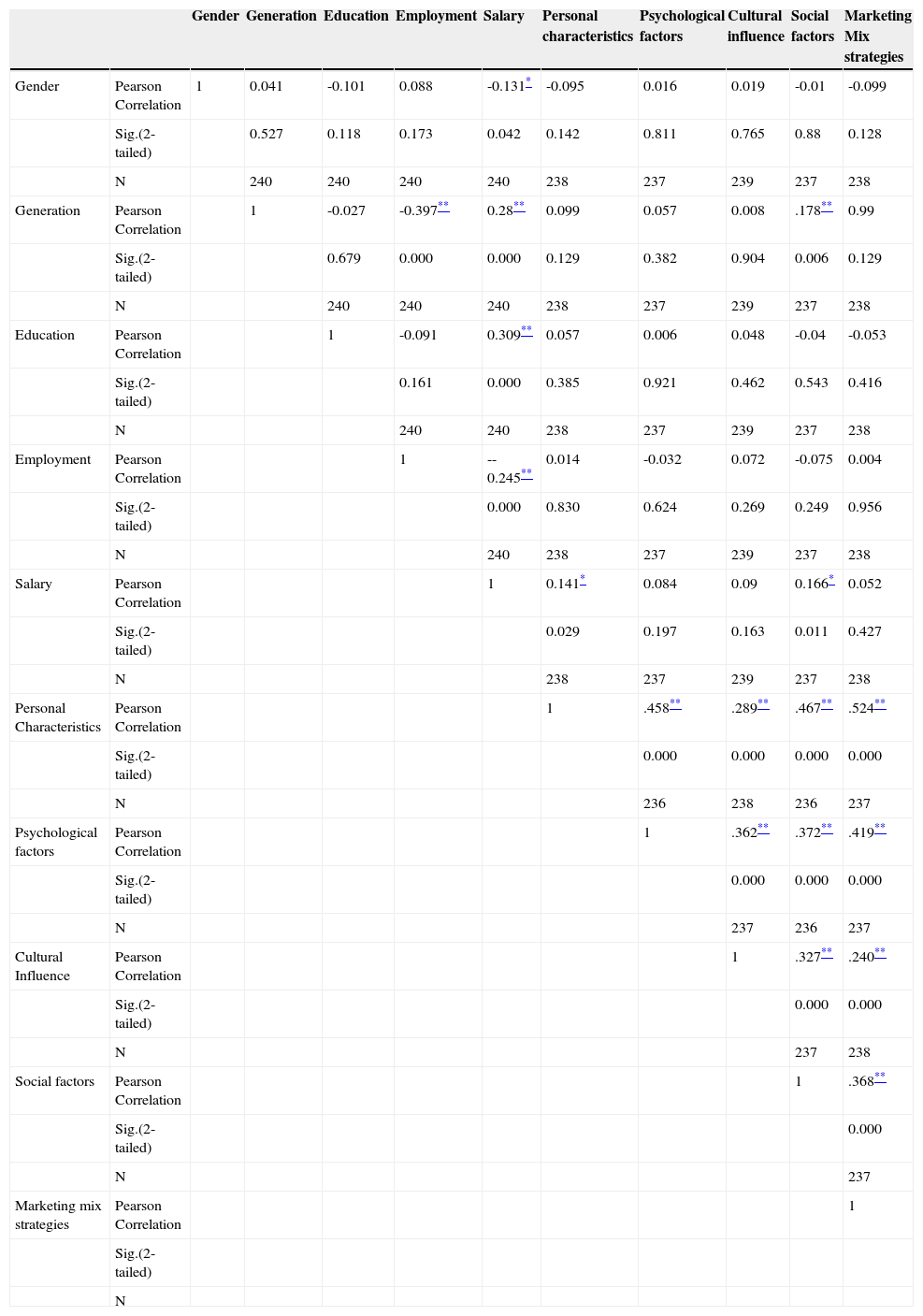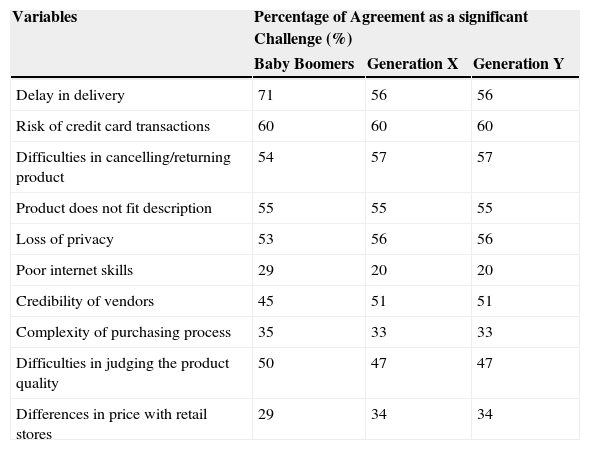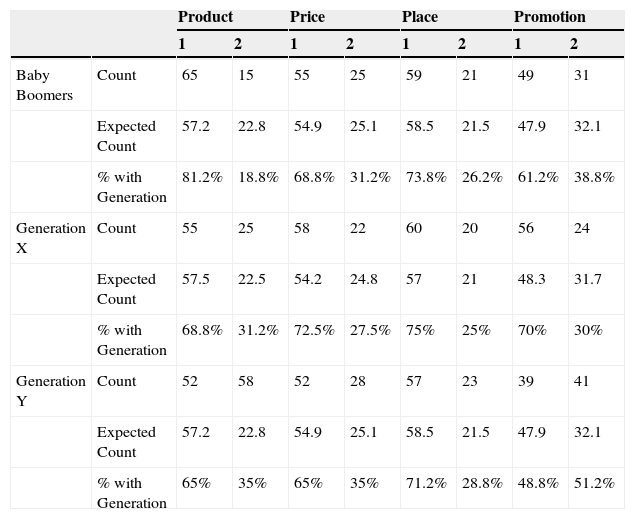The internet has created a revolutionary impact in everyday communications and transactions. It is considered the fastest growing mode used to shop. Internet shopping is also referred to as online shopping. Online shopping is a fast and efficient way for consumers to purchase products and services. The purpose of this research is to provide insight into issues related to online shopping. A survey was carried out among the public comprising of “Baby Boomers”, Generation “X” and Generation “Y” to identify their perceptions of online purchasing and the challenges they face with online purchasing. The results indicated that social factors have a significant relationship with online purchasing behavior of the three generations. The results also indicated that the challenge that is found to be most significant by the three generations is the risk of credit card transaction. It is recommended that further research can be done to study the relationship between gender and online purchasing behavior with a focus on the Malaysian scenario which is unique in its diversity of population.
La internet ha creado un impacto revolucionario en las comunicaciones y transacciones de todos los días. Se considera la modalidad de compras con el más rápido crecimiento. Las compras por internet son conocidas también como compras en línea. Las compras en línea es una manera rápida y eficiente para que los consumidores adquieran productos y servicios. El objetivo de esta investigación es esclarecer los problemas relacionados con las compras en línea. Se realizó una encuesta entre el público que comprendía a representantes de la generación de “baby boomers” (generación de posguerra), generación “X” (nacidos entre 1965 y 1981, inicios de internet) y generación “Y” (-también “millennials-nacidos entre 1982-1994, predominio de la tecnología) para identificar su percepción sobre las compras en línea y los retos a que se enfrentan con las compras en línea. Los resultados indicaron que hay una relación importante de los factores sociales con el comportamiento en las compras en línea de las tres generaciones. Los resultados indican también que el reto que encuentran las tres generaciones como más importante es el riesgo de las transacciones con tarjeta de crédito. Se recomienda llevar a cabo investigaciones adicionales para estudiar la relación entre género y comportamiento de compras en línea centrando la atención en el escenario de Malasia que es especial en su diversidad de población.
Since the introduction of the internet in the early 1980s, it has rapidly grown due to its unique characteristics of flexibility, interactivity, and personalization. According to Ko et al., (2004) as well as Koyuncu and Lien (2003), the internet is a very useful tool for communication, entertainment, education, and electronic trade. The is no doubt that internet is changing the way consumers shop and buy goods and services. According to Lim, Yap and Lau (2010), the internet has trans-formed the way business is done for it now enables retailers to offer unlimited range of products and services to all consumers from around the world at any point in time. They also went on to add that it can be considered as the most significant direct marketing channel for the global marketplace. As a result, it is now rapidly evolving into a global phenomenon (Jhe, 2014). Online shopping can be defined as a form of electronic devise for purchasing without any intermediary services (Gupta, 2013). Traditional shopping can be distinguished from online shopping for the former is a platform where one is allowed to evaluate purchases in person prior to purchasing while this opportunity is absent in the latter. According to Gupta (2013), there are many online shopping websites such as EBay, yebhi.com, shopping.rediff, futurebazzar.com, flipcard.com, indiangifts portals, 20north, fesyenandyou.com and 99labels.com. He further asserted that EBay and Amazon.com, the US based companies have taken online shopping to an entirely new level and they are the largest online retail corporations.
According to Joyce (2002) and Levitt (1983), technology and globalization make geography less relevant to consumption activities. There is no doubt that electronic commerce is shaking the root of business conventions in the current century. The development of the World Wide Web created a new sales channel for retailers, and thousands of companies have attempted to take advantage of this new method for reaching customers (Browne, Durrett and Wethebe, 2004). As a result of this trend, almost every firm that has launched online business or plans to do so is eager to know how to get in touch with more online buyers as much as possible (Sophia, Wong and Wong, 2006). However, it must be noted that since online transactions must be conducted through computer networks, an online buyer must be in the first place willing and capable to operate a computer. Sophia, Wong and Wong (2006) also added that a virtual store has advantages over a brick-and-mortar store in its ability to offer consumers more choices of products / services, satisfy customers’ specific needs, reduce search costs, and provide more convenient delivery and payment arrangements.
The obvious benefits of online shopping has resulted in the increasing number of internet users for this purpose. According to Jhe (2014), this growing number indicates the growing sense of comfort with the use of the internet for shopping. Roughly 10 percent of the world's population (more than 627 million people) have shopped online at least once (Jhe, 2014). Malaysia's online shopping market size was RM 1.8 billion in 2010 and it was estimated to be RM 5 billion in 2014 (Jhe, 2014). The current scenario shows a change in the trend of online shopping where in the past, consumers were mainly using online services to purchase/reserve airline tickets, hotel rooms, movie tickets and online books, but currently, more and more people are going online to buy apparels, cosmetics, accessories, shoes and other products. According to Lau, Lim, and Yap (2010), books and airline tickets are still the most common products and services purchased over the internet by Malaysian consumers. He asserted that the reason for this is the availability of information regarding these products prior to purchase or use.
Consumers can be categorized into three major groups comprising of Baby Boomers, Generation X and Generation Y. This division is based on age factor where researchers have asserted that generational cohorts are just one way to categorize a group of people with similarities for instance by using the era in which individuals were born and when they came of age. According to generational experts, Howe and Strauss (1991), generations are shaped by a particular span of time and they claim that it is a group of people who share a time and space in history that lends them a collective persona. They went on to add that the ‘span of a generation is roughly the length of a phase of life’. However, according to Mckindle and Wolfinger (2010), this definition is not entirely helpful today because the commonalities of today's generations have cut through global, cultural and socioeconomic boundaries. They went on to add that the impact of globalisation, largely made possible through the various technologies of today, the youth in Australia, the USA, the UK, Germany and Japan are shaped by the same events, trends and developments: they are avid users of social media and online technologies, are witnessing an unprecedented ageing in their populations, and are more financially endowed and formally educated than any generation preceding them. Based on the claims made by them, the researchers in this study have adopted Gibson et. al. (2009) categorization of the generations, where Baby Boomers are said to be born between 1946 to 1964, Generation X, between 1965 to 1980 and Generation Y, between 1981-2000. The selection was done with the presumption that the division could be said to cover generations in all the countries around the world including Malaysia. This concurs to the definition that a generation can be seen as a group of people born in the same era, shaped by the same times and influenced by the same social markers – in other words, a cohort united by age and life stage, conditions and technology, events and experiences (Mckindle and Wolfinger, 2010).
Many researchers in the past have studied purchasing behavior of these three generations. According to a study conducted by Forrester Research in the United States, Generation Y is the major user of internet technology followed by Generation X and lastly by Baby Boomers. A few studies have also been conducted on the relationship between segmentation of generational cohorts with purchasing behavior, more specifically in the domains of fashion (Littrell et al., 2005; Pentecost and Andrews, 2010), travel and tourism (Beldona, 2005), wine consumption (Fountain and Lamb, 2011) and fair-trade consumption (Ma et. al., 2012). It has also been found that the different experiences and preferences of various generational cohorts can result in differences in purchasing behavior and the level of buyer involvement for distinct types of products (Parment, 2013). From consumers’ perspective, the internet has provided more control in accessing information and they credit the pull for online content as a result from the opportunity given to decide when, where, what, and how much commercial content they wish to view.
The internet also allows consumers to access an unlimited range of products and services from companies around the world, and it has reduced the time and effort consumers spend on shopping (Ko et al., 2004 and Lim, Yap and Lau, 2010). Hernandez, Jimenez and Martin (2011) carried out a research to analyse whether individuals’ socioeconomic characteristcs, namely, age, gender and income influence online shopping behaviour. Their results indicated that these factors do not condition the behaviour of the experienced e-shopping. In their study, they also claimed that the effects of some variable thought to be crucial from findings from previous studies may have changed and this could be a result of the rapid evolution of of e-commerce in recent years. The research by Sorce, Perotti and Widrick (2005) conducted among 300 samples also indentified that age was negatively correlated with online pre-purchase search but was positively correlated with online purchasing when pre-purchase search behaviour was taken into consideration. The research conducted by Sorce, Perotti and Widrick (2005) revealed two interesting findings which must given voice here.
Firstly, it was found that there was not significant differences in terms of the act of shopping online but when asked if they had searched for or purchased specific products or services online, younger shoppers reported searching for more products than the older group. Secondly, when the search for the product was taken into consideration, older consumers were more likely to purchase once they had searched for the item online. Despite the numerous researches on purchasing behavior in relation to different generation, there is a gap in the research related to perceptions of the challenges of online purchasing among the three generations which this research aims to fill. This paper is divided into the following sections. The first section reviews the literature of online purchasing. The method section furnishes details on data collection, framework of study and analysis. Then, in the findings section, the analysis of the responses obtained from the survey are discussed. The conclusion section highlights the key findings and provides recommendation for future research.
Literature ReviewInternet and Online PurchasingThe internet has entered the mainstream consciousness of society over the past decade and Jhe (2014) attributes this to the web's graphical interface as well as the change in the controlling body, where it has moved from the government to the private sector. They went on to add that companies have started using the internet with the aim of cutting marketing costs, thereby reducing the price of the products and services in order to stay ahead in the highly competitive market. According to Changchit (2006), an increasing number of people are gravitating towards more intensive use of the internet as the accessibility of technology, the availability of information, and the ability to interact through the internet increase and evolve. Internet based services offer many advantages to providers and to users. Principal advantages are convenience, speed, accessibility, timeliness and cost effectiveness. However, the drawbacks are that many computer applications were originally designed to deliver these advantages rather than provide high levels of security (Johnson and Krone, 2007).
Apart from the issue of systems’ security, an internet user may also be vulnerable to exploitation or attack in terms of the security applied in conducting any online transaction (Johnson and Krone, 2007). Fraud and internet crime are recognised as important issues for governments and private businesses worldwide. An area of growing concern is the impact of criminal activity on householders who use the internet (Johnson and Krone, 2007). In addition, according to Browne, Durrett and Wethebe (2004), other internet business problems include the need to structure internal and external business processes to serve customers appropriately, the need to provide adequate technological and physical infrastructures, and the need to understand customer consumption processes in ‘virtual’ and physical environments. According to Hernandez, Julio and Martin (2011), in the last few decades, extensive research has been conducted into information technology (IT) adoption, testing a series of factors considered to be essential for improved diffusion and these researches can be divided into three groups where some studies analyse IT characteristics such as usefulness, ease of use and/or security (Davis, 1989; Yu et al., 2005), others focus on the emotions and experiences of users (Agarwal and Prasad, 2000; Fiore and Kim, 2007) and a third group attempts to determine the importance of socioeconomic user characteristics, such as age, gender, educational level, place of residence and income.
Online Purchasing and GenerationGeneration is a strong determinant of online purchasing behavior. This has been proven in past researches where generally it has been found that Generation Y contributes to the highest percentage of online purchasing, followed by Generation X and Baby Boomers. According to Lachman and Brett (2013), Generation Y takes shopping seriously and spends a lot of online time researching, fantasizing, considering flash-sale promotions, checking out what celebrities are wearing and then imagining how they would look in similar outfits, using pinterest.com to share items with family members, and keeping up with food and fashion blogs. This is supported by the findings of Consumer Behavior Report (2008) which stated Generation Y is more immersed in online and mobile activities including social networks (86%), podcasts (57%), blogs (50%) and text messaging (96%) than any other generation. However, the National Australia Bank's Online Retails Sales Index shows that online spending is dominated by Generation X (cited in Bainbridge, 2013). Although studies have indicated differences in their researches with regards to online purchasing and generation, it can generally be summed that the highest percentage of online shopping is done either by Generation X or Y with Baby Boomers being the lowest. As a result of the contradictions in the findings of research on age and online purchasing with some indicating that younger generation tend to shop more online (Dholakia and Uusitalo, 2002 and Joines et al., 2003) while others have found that older consumers were more likely to shop online (Donthu and Garcia, 1999 and Korgaonkar and Wolin, 1999), Sorce, Perotti and Widrick (2005) have concluded that demographic factors versus shopping motivations and attitudes in predicting online shopping remains an open question.
Consumers’ Perceptions on Online PurchasingConsumers’ perceptions towards online shopping has been broadly researched by various researchers and scholars with a wide range of methods to compare consumer behavior in online shopping to that of traditional offline shopping behavior (Gupta, 2013). According to Li and Zhang (2002), there are in-depth studies on online shopping attitudes and behavior in recent years where most of them have attempted to identify factors influencing or contributing to online shopping attitudes and behavior. Internet knowledge, income and education level were found to be powerful predictors of internet purchases among university students according to an online survey of 425 U.S. undergraduate and MBA students (Case, Burns, and Dick, 2001). Ho and Wu (1999) discovered that there are positive relationships between online shopping behavior and five categories of factors which include e-stores logistical support, product characteristics, websites technological characteristics, information characteristics and homepage presentation. Schubert and Selz (1999) examined the quality factors of electronic commerce sites in terms of information, agreement and settlement phases.
Researchers have also carried out various researches using different methods and have revealed findings that are similar as well as different with regards to consumers’ perceptions of online shopping. Changchit (2006) carried out a survey in South Western United States University (US) to identify the differences between consumers who prefer online shopping and those who prefer offline shopping. The responses from 107 individuals indicated differences in the perception of the consumers as to the factors of past experience, benefits, convenience and levels of uncertainty between those who preferred online shopping and those who did not. One significant finding was that positive past experience had a positive relationship with desire to shop online. Parment (2013) asserted that Baby Boomers in Sweden showed a higher degree of involvement for grocery product and paid more attention to optimizing purchase decision especially on clothes for example by avoiding poor quality of clothing and by making sure different elements of the wardrobe fit together as compared to Generation Y. On the other hand, Generation Y is more interested on online purchasing based on emotional involvement. In Malaysia, Mansori, Liat and Shan (2012) found that perceived benefits and website characteristics have a positive influence on generation X and Y's perceptions towards online shopping intention while perceived risk, perceived price and products/services attributes showed negative relation to online shopping. Another study in Malaysia by Tan (2012) focused on how various factors such as experiences studying abroad, use of internet and online shopping habits influenced consumers’ perceptions of the E-Commerce industry. He concluded that Malaysian consumers are heavy users of the internet but the differences were noted based on the factors stated. For example, consumers who had experience studying abroad did not find the inability to view the quality of the product as a deterrent.
Despite these extensive researches, perceptions of Malaysian online consumers are still limited especially with regards to challenges faced. Research to identify the differences between the perceptions of the three generation is also limited. Thus, this research aims to fill this gap by studying the perceptions and challenges of online purchasing from Baby Boomers, Generation X and Y's point of views. In the current study, the researchers aim to find answers to four specific research questions inclusive of the perspectives of Baby Boomers, Generation X and Generation Y on the factors that influence their intention to purchase online and the challenges they face with online purchasing. There is a significant need for this kind study for most studies done on factors affecting online shopping was done during the initial phase of development of IT where individuals were not using technology at the rate it is being done now (Hernandez, Jimenez, and Martin, 2011).
Factors Affecting Online PurchasingResearch on factors influencing online shopping is extensive (Bellman, Lohse and Johnson, 1999; Bhatnagar, Misra and Rao, 2000; Chang et al., 2004; Limayem et al., 2000; Sim and Koi, 2002; Ahn, Ryu and Han, 2004; Liu and Wei, 2003 as well as O’Cass and Fenech, 2003 cited in Thananuraksakul, 2007). Among the factors that have been highlighted by these researchers are convenience, time saving, ease of use, nature of products, competitive price and trust in online shopping. Besides these, according to Man (2012), other factors influencing online purchasing listed by researchers are online sellers’ websites and photos of products (Lohse and Spiller, 1998; Park and Kim, 2003), geography and store accessibility (Farag et al., 2006), perceived risk and online shopping benefits (Pires, Stanton, Eckford 2004), typology of online stores (Moe, 2003), pleasure and web trust (Ha and Stoel, 2009), attitudes to online shopping (Dittmar et al., 2004; Ahn, Ryu, and Han 2007) and the impact of consumers’ socio-economic conditions (Farag et al., 2006).
Challenges in Online PurchasingToday, although e-commerce technology has revolutionized the process of buying and selling of products/ services, the nature of online shopping which uses internet, network and web based technologies has brought to light numerous challenges associated with security, protection and trust (Udo, 2001; Roca, Garcia and Vega, 2009; Chen and Barnes, 2007; as well as Roman and Cuestas 2008 cited by Abdulghader et. al., 2012). Abdulghader et.al. also went on to add that there is increasing concern over online shopping because of insecurity, lack of customers’ protection and trust which are vital elements for a successful online transaction between countries, organizations as well as individuals. These findings are supported by Jun and Noor Ismawati Jaafar (2011), who claim that online security, privacy protection, and after-sales service are also challenges of online shopping. The Guardian (2014) reported that nearly half of consumers who bought goods online over the past two years had problems with their purchase and they listed deliveries arriving late, goods arriving faulty/damaged or goods not arriving at all as three of the most common challenges faced in online purchasing.
Research ObjectivesThe purpose of this research is to provide insight into issues related to online shopping. A survey was carried out among the public comprising of Baby Boomers, Generation X and Generation Y to identify their perceptions on the challenges they face with online purchasing. The specific objectives of this research are:
- •
To identify the factors affecting online purchasing among the three generations; Baby Boomers, Generation X and Generation Y.
- •
To evaluate the relationship between the factors affecting online purchasing and generations of online purchasers.
- •
To examine the challenges faced in online purchasing by the three generations; Baby Boomers, Generation X and Generation Y.
- •
To evaluate which marketing strategies influence the online purchasing behavior of the three generations.
The purpose of this study is to identify the factors affecting online purchasing among the three generations and to identify the challenges faced in online purchasing by them. In addition, the study also aimed to ascertain the marketing strategy that influences the online purchasing behavior of these three generations. In line with this, the researchers adopted a quantitative research method. According to Creswell (2013), a quantitative research method deals with statistical, mathematical or numerical data where data is collected through primary research from a large sample size and analyzed using statistical software. Accordingly, the researchers collected the data using a survey questionnaire with psychometric Likert Scale questions. A non-probability purposive sampling method was adopted. The questionnaire was distributed to 400 respondents from the three generations in Klang valley in Malaysia and 240 usable questionnaires were analyzed using SPSS. The questionnaire was divided into two parts which are Section A and Section B. There were six items in section A which were designed to seek demographic profile of the respondents including gender, age, education level, employment status, total numbers of year's employed and monthly basic salary. In section B, there were five items comprising of experience in online shopping, types of products/services purchased through online shopping, challenges faced in online shopping, factors influencing online purchasing behavior and marketing strategies that affects online purchasing behavior. The third item in section B used a five point Likert scale from 1 to 5, Very Important to Totally Unimportant. Items four and five were measured using the scale of 1 to 5, Strongly Disagree to Strongly Agree. According to LaMarca (2011), Likert–type scale is a scale that can be easily read and understood by the respondents as well as enables the researcher to easily construct and manage the data. A pilot test of the survey questionnaire was conducted on 30 respondents to identify flaws in the questionnaire. According to Crossman (2013), a pilot study is a research project that is conducted on a limited scale that allows researchers to get a clearer idea of what they want to know and how they can best find it out without the expense and effort of a full-fledged study. It also enables researchers to identify and rectify any flaws in the questionnaire.
The researchers used a framework that combines Kotler et.al (2005) and Mc Carthy's (1978) design as shown in figure 1.
Theoretical Framework (adapted from Kotler, 2005 and Mc Carthy, 1978)
This section of the paper discusses the findings of the research according to the four research objectives; to identify the factors affecting online purchasing among the three generation; Baby Boomers, Generation X and Generation Y, to evaluate the relationship between the factors affecting online purchasing and generations of online purchasers, to examine the challenges faced in online purchasing by the three generations; Baby Boomers, Generation X and Generation Y and to evaluate the marketing strategies that affect the three generations intention to purchase on line. Prior to the discussion, a brief description of the demographics related to the sample used in the study is given. A total of 400 questionnaires were distributed among the three generations comprising of both males and females. Out of this, 310 were returned. The researchers randomly selected 80 from each generation to ensure results are reflected accurately. Thus, the analysis was based on 240 samples. The demographics of these samples are shown in Table 1.
The findings indicate that a total of 55% (132) of this samples were males and 45% (108) were females.
Since past literature indicates that educational background and income plays a significant role in determining the consumers’ intention to purchase online, the researchers sought to identify this background information through the questionnaire. Table 2 and 3 indicate the findings.
As shown in Table 2, 25% of Baby Boomers are degree holders, 23% are Masters holders and 10% are PhD holders. With regards to Generation X, 61% are degree holders, 15% are Masters holders and 6 are PhD holders. A large percentage, 81% of the Generation Y, are pursuing a Bachelor's degree or have completed their first degrees, 6% are master holders and 1% are PhD holders.
Table 3 indicates that the largest percentage (36%) of the Baby Boomers are earning an income of RM 8000 and above while the majority of Generation X (34%) fell under the income group of RM 2000 to RM 4000. On the other hand, a large percentage (31%) of Generation Y are earning an income ranging between RM 2000 and below.
The income groups of the rest are distributed under the other income brackets: RM 2000 and below, RM 2001 to RM 4000, RM 4001 to RM 6000, and RM 6001 to RM 8001 and above. The researchers used the educational background and income as variables to identify if these variables were significantly related to the perception of shopping online. This will be discussed further.
The samples’ employment status and number of years employed were also identified as past literature has indicated that there is a significant relationship between these with the intention to purchase online. Table 4 and 5 indicate the findings.
Number of Years Employed.
| Frequency | Percent | Valid Percent | Cumulative Percent | ||
|---|---|---|---|---|---|
| 0 | 12 | 5 | 5 | 5 | |
| Less than 1 year | 55 | 22.8 | 22.9 | 27.9 | |
| 1-5 years | 30 | 12.4 | 12.5 | 40.4 | |
| Valid | 6-10 years | 29 | 12 | 12.1 | 52.5 |
| 11-15 years | 25 | 10.4 | 10.4 | 62.9 | |
| 16 years and above | 89 | 36.9 | 37.1 | 100 | |
| Total | 240 | 99.6 | 100 | ||
| Missing | System | 1 | 0.4 | ||
| Total | 241 | 100 |
Table 4 shows that a large percentage of the samples are employed fulltime (59%). 24% of the samples are unemployed. These samples are representatives of Generation Y and they are still studying. A small percentage of samples are freelance workers (8%), part time workers (6%) and contract workers (2%).
Table 5 shows the years of experience of the samples. In terms of years of experience, a large percentage have been working for more than 16 years (37%). On the other hand, 10% of the samples have been working between 11 to 15 years, 12% between 6 to 10 years, 12% between 1 to 5 years and 23% less than a year.
Online Purchasing Experience According to Gender and GenerationsFrom the questionnaire collected, the researchers did a frequency count as to the number of samples according to gender and generation who have done online shopping. Table 7 and 8 show the findings.
The findings in Table 6 indicate that both males and females have experience shopping online. 80% of males and 78% of females from the sample size have previously done online shopping. Thus, it shows that there is not much difference according to gender with regards to purchasing online. This findings contradicts past researchers (Alreck and Settle, 2002; Brown et al., 2003; Donthu and Garcia, 1999; Korgaonkar and Wolin, 1999; Levy, 1999; Li et. al., 1999; Rodgers and Harris 2003; Slyke et al., 2002 and Stafford et al., 2004 cited in Zhou, 2007) who found that male consumers make more online purchases and spend more money online than females; they are equally or more likely to shop online in the future, and are equally or more favorable of online shopping. Literature review has also revealed that most of the internet shoppers are men, earning high incomes and owning a university education (Dholakia and Uusitalo, 2002; Li et al., 1999; Vrechopoulos et al., 2001 cited in Nayyar and Gupta 2010).
Online Purchasing Experience According to Gender.
| Have you done any online shopping? | Total | |||||
|---|---|---|---|---|---|---|
| Yes | No | Missing | ||||
| Gender | Male | Count | 105 | 27 | 0 | 132 |
| % within Gender | 79.5% | 20.5% | 0% | 100% | ||
| Female | Count | 84 | 23 | 1 | 108 | |
| % within Gender | 77.8% | 21.3% | 0.9% | 100% | ||
| Total | Count | 189 | 50 | 1 | 240 | |
| % within Gender | 78.8% | 20.8% | 0.4% | 100% | ||
The findings in Table 7 indicate that all three generations do some form of purchasing online. However, both Generation X and Y do it more than Baby Boomers. 83% of Generation X and 81% of Generation Y have purchased products/ services online. In the case of Baby Boomers, only 73% have done online shopping. The higher percentage of Generation X and Y purchasing online is linked to the fact that these generations were born during the time when technology had already advanced. The findings of this research is supported by Parment's (2013) study on Generation Y which indicated that the constant and overwhelming flow of information has become the rule for them as they are multi-taskers who use their mobile phones for just about anything. Parment's findings can also apply to Generation X. According to Hernandez, Jimenez and Martin (2011), a review of of literature shows that computer skills are more easily learned by younger individuals (Czara et. al., 1989) and older people perceive greater risks (Morris and Venkatesh 2000). Further they citied Trocchia and Jada, (2008) who also showed similar findings where they listed three obstacles which make older consumers reluctant to do online shopping which comprise lack of IT experience, resistance to change and their insistence on trying out the product before purchase. These findings are proven true in the current study which shows the Generation X and Y do online purchasing to a larger degree compared to Baby Boomers.
Online Purchasing Experience According to Generations.
| Have you done any online shopping? | Total | |||||
|---|---|---|---|---|---|---|
| YES | NO | Missing | ||||
| Generation Y | Count | 65 | 15 | 0 | 80 | |
| % within Generation | 81.2% | 18.8% | .0% | 100.0% | ||
| Generation | Generation X | Count | 66 | 14 | 0 | 80 |
| % within Generation | 82.5% | 17.5% | .0% | 100.0% | ||
| Baby Boomers | Count | 58 | 21 | 1 | 80 | |
| % within Generation | 72.5% | 26.2% | 1.2% | 100.0% | ||
| Total | Count | 189 | 50 | 1 | 240 | |
| % within Generation | 78.8% | 20.8% | .4% | 100.0% | ||
Prior to analyzing the factors that affects the online purchasing among the three generations, the researchers sought to identify the most common products purchased by the three generations and also the preferred method of purchasing these products. A list of commonly purchased products was given to the samples who were then asked to identify their preferred method of purchase; over the internet or at the retail store. The selection of products was made based on a pilot study that was carried out to identify the most commonly purchased products at a regular basis. Table 8 shows the findings.
Commonly Purchased Product (%).
| Baby Boomers | Generation X | Generation Y | ||||
|---|---|---|---|---|---|---|
| Variables | Online | Retail | Online | Retail | Online | Retail |
| Groceries | 1 | 99 | 6 | 94 | 4 | 96 |
| Cosmetics | 10 | 90 | 15 | 85 | 6 | 94 |
| Books/ CDs | 26 | 74 | 30 | 70 | 25 | 75 |
| Clothes | 9 | 91 | 16 | 84 | 24 | 76 |
| Furniture | 5 | 95 | 14 | 86 | 9 | 91 |
| Electronic gadgets | 21 | 79 | 30 | 70 | 25 | 75 |
| Computers/Mobiles | 19 | 81 | 30 | 70 | 14 | 86 |
| Airline/Railway tickets | 51 | 49 | 59 | 41 | 74 | 26 |
| Cinema tickets | 65 | 35 | 72 | 28 | 74 | 26 |
| Holiday packages | 49 | 51 | 58 | 42 | 59 | 41 |
Out of the ten products/services given in the list, the findings indicated that the three generations’ preferred method of purchasing was similar for three specific products: cinema tickets (Baby Boomers, 65%, Generation X, 72% and Generation Y, 74%), airlines/ railway tickets (Baby Boomers, 51%, Generation X, 59% and Generation Y, 74%), and holiday packages (Baby Boomers, 49%, Generation X, 58% and Generation Y, 59%) where they all opted buying over the internet as their preferred method. One significant observation is that in the case of holiday packages, the difference in percentage of Baby Boomers’ preference between purchasing at retail store and online is not very significant (2%). The rest of the seven products inclusive of groceries (Baby Boomers, 99%, Generation X, 94% and Generation Y, 96%), cosmetics, (Baby Boomers, 90%, Generation X, 85% and Generation Y 94%), books/CDs (Baby Boomers, 74%, Generation X, 70% and Generation Y, 75%), clothes (Baby Boomers, 91%, Generation X, 84% and Generation Y, 76%), furniture (Baby Boomers, 95%, Generation X, 86% and Generation Y, 91%), electronic gadgets (Baby Boomers, 79%, Generation X, 70% and Generation Y, 75%), and computer products/mobiles (Baby Boomers, 81%, Generation X, 70% and Generation Y, 86%) showed a tendency among the samples from the three generations to purchase at retail stores. The findings here contradicts the findings of Monsuwé et al. (2004 cited in Haslingger, Hodzic, Opazo, 2007) who compared the traditional way of shopping and online shopping and concluded that online shopping is a more convenient way compared to the traditional ones. His conclusion was based on the fact that the internet allows for more information to be gathered with a minimal amount of effort, inconvenience, and invested time by the consumer. Monsuwe's findings is applicable to the current findings where the samples from the three generations preferred purchasing cinema tickets, airline/ railway tickets and holiday packages online. This is probably because the above activities are time consuming.
Table 9 shows the relationship between the factors affecting online purchasing and generation of online purchasers.
Relationship between the Factors Affecting Online Purchasing and Generation of Online Purchasers.
| Gender | Generation | Education | Employment | Salary | Personal characteristics | Psychological factors | Cultural influence | Social factors | Marketing Mix strategies | ||
|---|---|---|---|---|---|---|---|---|---|---|---|
| Gender | Pearson Correlation | 1 | 0.041 | -0.101 | 0.088 | -0.131* | -0.095 | 0.016 | 0.019 | -0.01 | -0.099 |
| Sig.(2-tailed) | 0.527 | 0.118 | 0.173 | 0.042 | 0.142 | 0.811 | 0.765 | 0.88 | 0.128 | ||
| N | 240 | 240 | 240 | 240 | 238 | 237 | 239 | 237 | 238 | ||
| Generation | Pearson Correlation | 1 | -0.027 | -0.397** | 0.28** | 0.099 | 0.057 | 0.008 | .178** | 0.99 | |
| Sig.(2-tailed) | 0.679 | 0.000 | 0.000 | 0.129 | 0.382 | 0.904 | 0.006 | 0.129 | |||
| N | 240 | 240 | 240 | 238 | 237 | 239 | 237 | 238 | |||
| Education | Pearson Correlation | 1 | -0.091 | 0.309** | 0.057 | 0.006 | 0.048 | -0.04 | -0.053 | ||
| Sig.(2-tailed) | 0.161 | 0.000 | 0.385 | 0.921 | 0.462 | 0.543 | 0.416 | ||||
| N | 240 | 240 | 238 | 237 | 239 | 237 | 238 | ||||
| Employment | Pearson Correlation | 1 | --0.245** | 0.014 | -0.032 | 0.072 | -0.075 | 0.004 | |||
| Sig.(2-tailed) | 0.000 | 0.830 | 0.624 | 0.269 | 0.249 | 0.956 | |||||
| N | 240 | 238 | 237 | 239 | 237 | 238 | |||||
| Salary | Pearson Correlation | 1 | 0.141* | 0.084 | 0.09 | 0.166* | 0.052 | ||||
| Sig.(2-tailed) | 0.029 | 0.197 | 0.163 | 0.011 | 0.427 | ||||||
| N | 238 | 237 | 239 | 237 | 238 | ||||||
| Personal Characteristics | Pearson Correlation | 1 | .458** | .289** | .467** | .524** | |||||
| Sig.(2-tailed) | 0.000 | 0.000 | 0.000 | 0.000 | |||||||
| N | 236 | 238 | 236 | 237 | |||||||
| Psychological factors | Pearson Correlation | 1 | .362** | .372** | .419** | ||||||
| Sig.(2-tailed) | 0.000 | 0.000 | 0.000 | ||||||||
| N | 237 | 236 | 237 | ||||||||
| Cultural Influence | Pearson Correlation | 1 | .327** | .240** | |||||||
| Sig.(2-tailed) | 0.000 | 0.000 | |||||||||
| N | 237 | 238 | |||||||||
| Social factors | Pearson Correlation | 1 | .368** | ||||||||
| Sig.(2-tailed) | 0.000 | ||||||||||
| N | 237 | ||||||||||
| Marketing mix strategies | Pearson Correlation | 1 | |||||||||
| Sig.(2-tailed) | |||||||||||
| N |
Past researchers have identified numerous factors that influence online purchasing behavior. Based on these findings, four main categories of factors were identified: personal characteristics psychological factors, factors related to cultural influence and social factors. The respondents were asked to indicate their agreement on whether these factors affect their intention to purchase online. A correlation analysis was done to determine the relationship between the variables. The analysis was done to determine whether the demographic factors such as gender, generation, education, employment and salary influences the consumers’ online purchasing behavior.
The result proved that there is a positive correlation between generation and social factors with (r= 0.178, sig. level= 0.006). The social factors indicated in the questionnaire comprise the following statements; products are also used by family and friends, products are endorsed by celebrities, suppliers are engaged in corporate social responsibility and there is online feedback of products. The findings indicate that these factors are significant in influencing the consumers’ decision to do online purchasing. Meanwhile the findings indicated that personal characteristics, psychological factors, factors related to cultural influence and marketing mix strategies did not significantly influence the generations in their online purchasing behavior. Besides that, the income of consumers also has a significant positive relationship with personal characteristics (r= 0.141, sig. level 0.029) and social factors (r=0.166, sig. level 0.11).
The personal characteristics include lifestyle, the liking for the products, current position whether they are students, office workers or professionals as well as trends of the generations. This proved that consumers who have high incomes do more online shopping. Baby Boomers, who earned higher also, prefered to buy products of current trends to upgrade their lifestyle. This finding is consistent with previous researchers where it was found that income is positively related to the tendency to shop online (Bagchi and Mahmood 2004; Donthu and Garcia, 1999; Korgaonkar and Wolin, 1999; Li et al., 1999; Susskind 2004 cited in Zhou 2013; Cunningham and Cunningham, 1973 cited in Nayyar and Gupta 2010). The findings also indicated that psychological factors, factors related to cultural influence and marketing mix strategies have negative relationship with salary. In the studies of Hernandez, Jimenez and Martin (2011), higher income causes internet users to perceive lower implicit risks in online purchasing and thus increase their demand for such activity while on the other hand, low income is a deterrent to online transactions as they do not have the ability to withstand possible financial losses.
The findings in this study is consistent with past literature. However, caution must be taken in coming to a conclusion as the study of Hernandez, Jimenez and Martin (2011) has also proven that the user's income only has effect on the first e-commerce activity which changes once users have acquired experience in the activity. Their view is supported by the study of Al-Somali et. al. (2009). This research, however, did not study the difference in relationship between age and first instance of online purchasing and subsequent online purchasing. At this point, it is also important to take note of the implication from Sorce, Peratti and Widrick's study (2005) where it is stated that different marketing approaches are necessary for the different consumer age segments. Older consumers may need to be induced to get online in the first place, while younger consumers will require enticement to translate their shopping and browsing into actual purchasing.
Challenges Faced in Online Purchasing by Baby Boomers, Generation X and Generation YThe researchers asked the samples to identify the common challenges that they face in online shopping. Ten challenges selected from findings of past researchers were used as variables and the respondents were asked to evaluate if they found them to be a challenge during their online purchasing. The findings are indicated in Table 10.
Challenges faced in online purchasing.
| Variables | Percentage of Agreement as a significant Challenge (%) | ||
|---|---|---|---|
| Baby Boomers | Generation X | Generation Y | |
| Delay in delivery | 71 | 56 | 56 |
| Risk of credit card transactions | 60 | 60 | 60 |
| Difficulties in cancelling/returning product | 54 | 57 | 57 |
| Product does not fit description | 55 | 55 | 55 |
| Loss of privacy | 53 | 56 | 56 |
| Poor internet skills | 29 | 20 | 20 |
| Credibility of vendors | 45 | 51 | 51 |
| Complexity of purchasing process | 35 | 33 | 33 |
| Difficulties in judging the product quality | 50 | 47 | 47 |
| Differences in price with retail stores | 29 | 34 | 34 |
The findings indicated that the challenge that is found to be the most significant by the three generations is the risk of credit card transaction (60%). Six other challenges that all three generations indicated as significant are delay in delivery (Baby Boomers, 71%, Generation X, 56% and Generation Y, 56%), difficulties in cancelling/returning product delivery (Baby Boomers, 54%, Generation X, 57% and Generation Y, 57%), loss of privacy (Baby Boomers, 53%, Generation X, 56% and Generation Y, 56%), product does not fit description (Baby Boomers, 55%, Generation X, 55% and Generation Y, 55%), difficulties in judging product quality (Baby Boomers, 50%, Generation X, 47% and Generation Y, 47%) and credibility of vendors (Baby Boomers, 45%, Generation X, 51% and Generation Y, 51%). The high percentage of samples indicating judging product quality as a significant challenge is consistent with the findings of past researches. It is commonly understood that the inability to physically examine products when shopping online increases the risk associated with online shopping. Bhatnugan Misra and Rao (2000) concluded that risks associated with not getting what was expected and credit card could negatively affect online shopping. According to past researchers, consumers often use product brand name (Dawar and Parker, 1994; Greatorex and Mitchell, 1994) and store name (Bolton and Drew, 1991; Teas and Agarwal, 2000) as a surrogate for product quality in order to reduce their risks and simplify their purchase decision, especially when shopping online, where many product attributes cannot be examined directly. According to Sorce, Perotti and Widrick (2005), Bhatnagar et. al's study (2000) identifies two types of risk which are product category risk and financial risk which generally decrease the likelihood of online purchasing behaviour. They concluded that the perception of convenience and informativeness in making good choices has a positive influence on intention to purchase online while high perceived risk has negative influence. The findings of this study is consistent with these reseraches.
One interesting finding is the three generations did not cite poor internet skills as a challenging factor as the percentage of respondents agreeing that it is a challenge is very low (Baby Boomers, 29%, Generation X, 20% and Generation Y, 20%). The differences in price of product sold online and at retail stores was also not indicated as a significant challenge (Baby Boomers, 29%, Generation X, 34% and Generation Y, 34%). The complexity of the purchasing process was also not highlighted as a significant challenge. (Baby Boomers, 35%, Generation X, 33% and Generation Y, 33%).
Marketing strategies employed in online purchasing that are most preferred by the three generationsMarketing Strategies.
| Product | Price | Place | Promotion | ||||||
|---|---|---|---|---|---|---|---|---|---|
| 1 | 2 | 1 | 2 | 1 | 2 | 1 | 2 | ||
| Baby Boomers | Count | 65 | 15 | 55 | 25 | 59 | 21 | 49 | 31 |
| Expected Count | 57.2 | 22.8 | 54.9 | 25.1 | 58.5 | 21.5 | 47.9 | 32.1 | |
| % with Generation | 81.2% | 18.8% | 68.8% | 31.2% | 73.8% | 26.2% | 61.2% | 38.8% | |
| Generation X | Count | 55 | 25 | 58 | 22 | 60 | 20 | 56 | 24 |
| Expected Count | 57.5 | 22.5 | 54.2 | 24.8 | 57 | 21 | 48.3 | 31.7 | |
| % with Generation | 68.8% | 31.2% | 72.5% | 27.5% | 75% | 25% | 70% | 30% | |
| Generation Y | Count | 52 | 58 | 52 | 28 | 57 | 23 | 39 | 41 |
| Expected Count | 57.2 | 22.8 | 54.9 | 25.1 | 58.5 | 21.5 | 47.9 | 32.1 | |
| % with Generation | 65% | 35% | 65% | 35% | 71.2% | 28.8% | 48.8% | 51.2% | |
The researchers asked the respondents to identify which marketing strategies affects their online purchasing behavior and the results indicated that for the Baby Boomers, the product strategy was the most significant (81.2%) followed by place (73.8%), price (68.8%) and lastly promotion (61.2%). In the case of Generation X, the findings indicated a difference where place was indicated as the most significant (75%), followed by price (72.5%), promotion (70%) and lastly product (68.8%). The perceptions as to the strategy which had a significant impact on the decision to purchase online for the Generation Y was similar to Generation X where they identified place as the most significant variable (71.2%), followed by both product and price (65%) and promotion (48.8%). In this study, the researchers did not expand the term ‘promotion’ with that of trust as done by some researchers (Bhattacherjee, 2002; Gefen, 2003; Mc Knight, Choudhury, Kacmar, 2002 and Yoon, 2002). According to Chang et. al, all these researchers found a significant positive effect of trust on intention to purchase where trust is conceptualized as a construct where the truster (online purchaser) is willing to be vurnable to the action of the trustee (marketer or producer).
ConclusionThis research was carried out among samples from the three generations to identify the perceptions and challenges of online shopping in Malaysia. The purpose was to identify whether there were any differences between the perceptions of the three generations. The findings indicated that the percentage of both females and males shopping online is almost similar. With regards to generations, the findings is consistent with past literature where it is shown that generation X and Y do online shopping more than Baby Boomers. In terms of products that are most purchased online by the three generations include cinema tickets, airline/railway tickets and holiday packages. The findings on the factors affecting online purchasing indicated that personal characteristics, psychological factors, cultural influence and marketing mix strategies do not significantly influence the generations in their online purchasing behavior. The only factor that was found to be significant in influencing the consumers’ decision to do online purchasing is social factors which comprised of products used by family and friends, products endorsed by celebrtity, suppliers engaged in corporate social responsibility and there is online feedback of product. In terms of challenges of online purchasing, all three generations indicated risk of credit card transaction as the most significant.
The limitations in this study include the sample size which is relatively small for generalisations. A larger sample would give more valid results. The research also did not take into consideration the difference in perception of a new user with that of an experienced user to online shopping. Another limitation is that the characteritics of Malaysia's unique population which is rich in cultural diversity with its unique practices and tabbos was not taken into consideration in the analysis of the sample's perceptions and challenges of online shopping. Thus, it is recommended that research in this area can be further extended to analyze the differences in perceptions between the three predominant races in Malaysia as well as differences between the genders. It is also recommended that online marketers take into consideration the challenges that are perceived by online purchasers in order to cultivate a good impression on online shopping among the three generations.
Peer Review under the responsibility of Universidad Nacional Autónoma de México.




